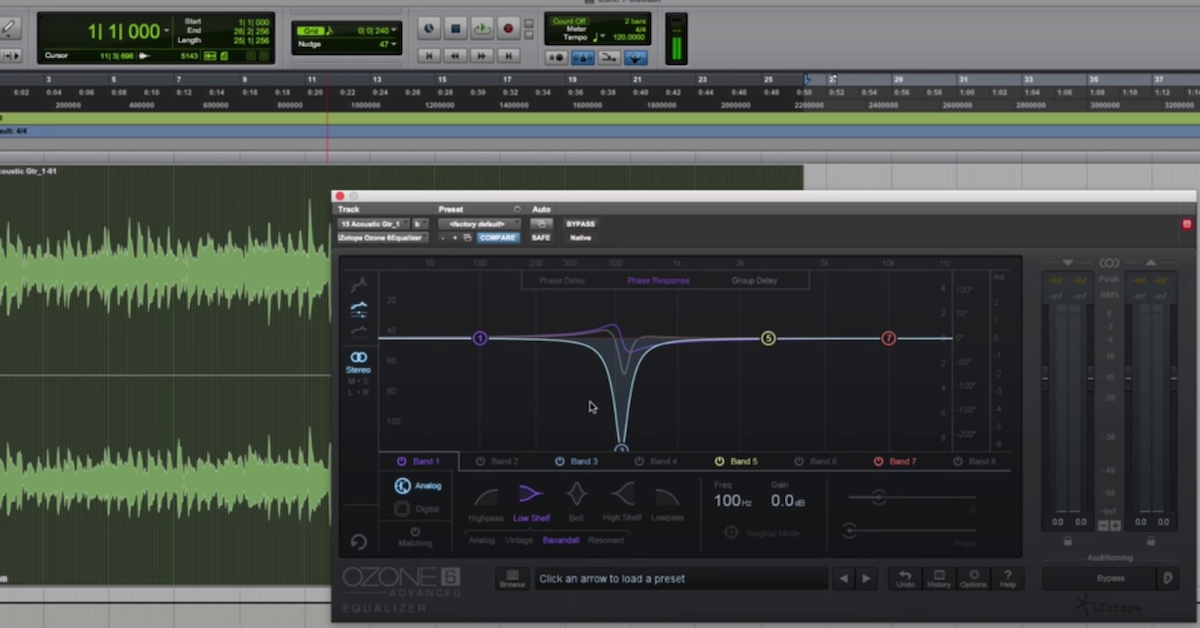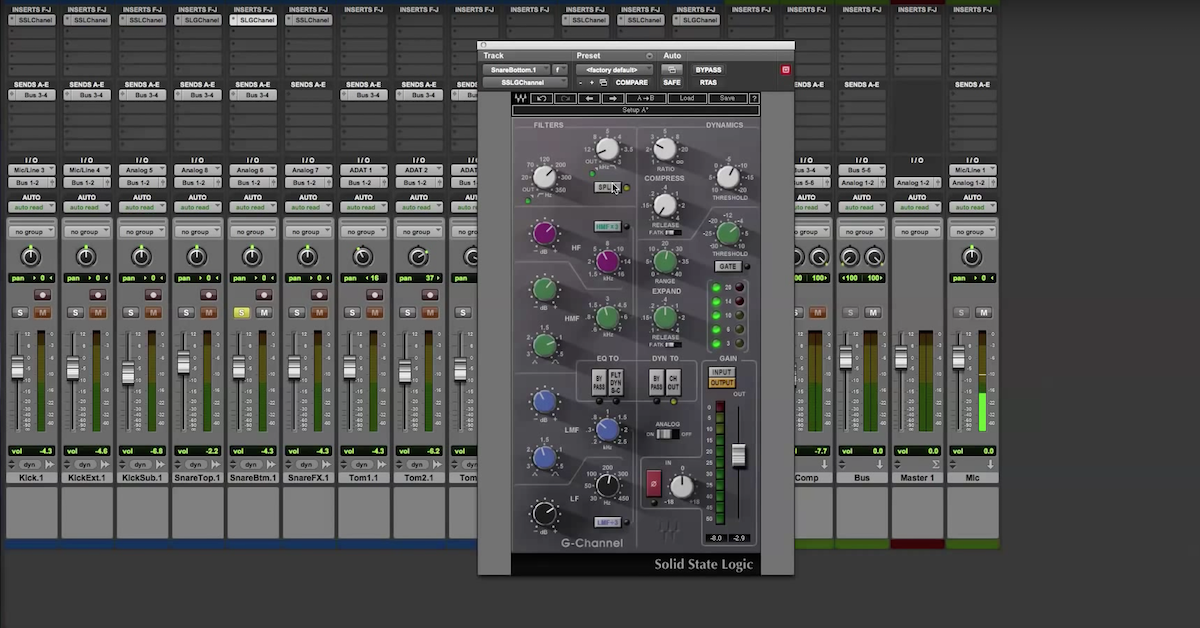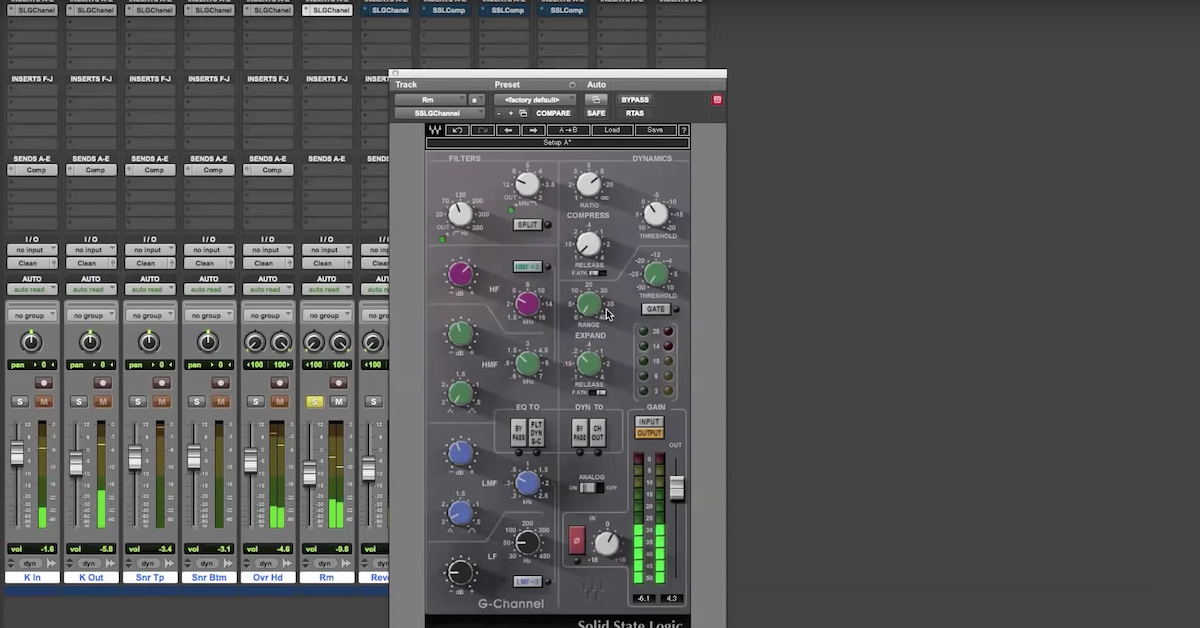The Complete Guide to Mixing with EQ
Article Content
In the hierarchy of mixing tools, I place level at the top, panning second and EQ third — making it, in my mind, one of the most important aspects of mixing to master.
Before explaining how I conceptualize and utilize EQ to make great mixes, I’m going to head into some technical stuff. I’ll go lightly because honestly, for most purposes, it’s not really important to dig in like that.
I’ll start with the low-pass filter. The basic idea is that a capacitor requires time to charge up. When it’s uncharged it acts as a barricade that blocks signal. When it’s charged it acts like it’s just part of the wire it’s attached to (this is an oversimplification so don’t nerd-rage on me).
Lower frequency signals stay pushing current in the same direction for a longer period of time. With lower frequencies, the capacitor has time to react by charging up and allows the signal to pass. The faster the signal, the less time the capacitor has to charge, and the more the capacitor naturally stops signal from coming through. The relationship between the resistor and the capacitor determines the inflection point where the frequency of the signal is equal to the exact time the capacitor needs to charge.
A high-pass filter is essentially the same thing. If the capacitor is allowing lower frequencies to move through and telling high frequencies to go elsewhere, then the type of circuit really just depends on where those split signals are going. If we take the high-frequency signals to ground, we have a low-pass filter. If we take the low frequency to ground, we have a high-pass filter. The signal that we terminate is called the “stopband” and the signal that we allow to pass through is sensibly called the “passband.”
In a very basic design, we can take the passband of a filter and feed back through an amplifier to create a shelf. Or we can smoosh a high-pass and low-pass together to create a band-pass, and then feedback to create a bell shape boost/cut. These circuits not only exist in EQs but in microphones and preamps to help “tune” the response as well.
Of course, there are some changes that occur to the signal along the way. The act of passing a signal through a filter causes a gradual change in the signal’s periodic placement with respect to frequency. This is called phase shift. Fast changes in phase can actually create anomalous oscillations, as can drastic degrees of positive feedback. This is called ringing.
In addition, a signal with phase shift when recombined with a signal without phase shift will cause a non-linear frequency response in both the passband and stopband. This unintended change in frequency response is called ripple. Lastly, there are non-linear responses to the signal both in terms of frequency response and amplitude due to the micro-timing delays that occur when a signal passes through components and is then re-summed with a signal that isn’t.
So, if you aren’t throwing your computer against the wall after reading all that; first — congratulations, and second, if you’re a bit overwhelmed, just suffice to say using an EQ comes with some sonic tradeoffs.
I just wanted to establish a basic concept of what is really happening when we EQ something. This will come into play later when we discuss how we are using the EQ and what type of EQ we are using.
Let’s talk about why you are really here: What do we do with an EQ?
Ultimately when it comes to EQ, there are really only three reasons to reach for one.
1. Correct or Augment a Source
Sometimes an element just wasn’t tracked perfectly — which happens a lot. Perhaps we didn’t have the perfect mic in the perfect room or even the instrument itself was a little off from what we wanted.
We can reach for an EQ to balance the tonality of what we want from that instrument. Too much room tone? Cut a little lower mid. The mic is a bit dark, add a high-shelf. Little too much proximity buildup? Shelf off a bit of lows.
We can also use an EQ to make the source bigger than what it naturally sounds like. A natural sounding snare is cool for a lot of music, but if we’re doing some heavy rock I might reach for an EQ to bump a little extra low end and make that snare extra fat and thumpy.
The realism might go out the window, but the impact and feel of the record is vastly more important. Same thing with kicks. It’s hard to find a kick drum with a ton of energy under 60Hz — but there is something to be said for boosting the living crud out of that range on an EQ to make that kick move the speakers. There’s also plenty of examples of this on sources that aren’t drums — but who cares about sources that aren’t drums, really?
2. Sculpt the Tonal Relationship Between Sources
Of course, once we have our main source tonally sounding great on its own, we quickly discover that it doesn’t sound the same once the rest of the arrangement is in … Oops! Turns out as great as the acoustic guitar sounded with all that top end sparkle, now that the cymbals are in (or 16th note programmed hi-hats if you’re feeling trill) that top end is just sounding a bit all over the place.
We’ve got a couple choices: change the tone of the cymbals or change the tone of the guitar. Similarly, our vocals sound perfectly tracked on their own, but in the mix, it turns out we end up losing the 100Hz weight up against the piano and bassoon. I’m assuming your record has a bassoon. This means we either need to cut out some lows from our piano/bassoon or maybe roll off a bit from our vocal and play to the upper mid tones of the voice instead. Turns out perception actually changes a lot when the mix comes together and it becomes pretty apparent that we don’t need a lot of the tone that sounded so great on its own.
3. Special FX
Sometimes we just want something to sound quirky. An example would be “the telephone effect” like the adlib tracks on every rap song for the last three years. That’s an odd sounding effect where you center a bandpass filter around 1.5kHz effectively eliminating all the top and bottom end. Or “the moving filter effect” which has been happening in the verse section of every EDM-influenced pop song for the last three and a half years. This creates the sensation of the music being far away or under a blanket and gradually opening up as we approach the pre-chorus. In fact, there are many ways to create special EQ FX, particularly if we incorporate automation. Filterfreak from Soundtoys is a great tool for creating really unique EQ effects.
When it comes to doing these jobs, there are a number of different tools we have at our disposal. And some will prove more effective than others. There are a number of different filter shapes as well as styles. I’ll start by talking about our common filters, and then move on to some more technical stuff with our filter architecture.
Hi-Pass/Low-Pass
The most basic filter is the hi-pass/low-pass filter. As discussed earlier, this is a filter that progressively attenuates frequencies that are below/above the corner frequency. These are useful for eliminating rumble or hiss, or simply rolling off a tone that isn’t necessary in the element to being with.
For example, if our arrangement includes drums, bass, acoustic guitar, electric guitars and vocals — we usually don’t need much bass tone from the acoustic guitar or vocals, and we don’t really need much sub tone from those or the electric guitars. By rolling these tones out we allow the kick and bass to push through and dominate the low end. So while it’s a bit counterintuitive, rolling off low end in some sources actually allows the mix to feel more powerful in the low end.
Similarly, we might not need the stuff above 6kHz in our electric guitars — particularly if the amps are really “gainy”. A low-pass filter on the electrics can help the cymbals really stand out.
In regards to pass filters, there is something called slope. This refers to how fast the attenuation progresses. A “6dB per octave” slope is considered a gradual slope. That means that if we set our corner frequency to 200Hz with a 6dB/octave high pass filter, 100Hz is being attenuated by 6dB, 50Hz is being attenuated 12dB, and 25Hz is being attenuated 18dB. A steeper filter like 12dB would be twice as aggressive, attenuating 12dB at 100Hz and 24dB at 50Hz, and so on. The positive of a steeper filter is that we eliminate more of the unwanted tones, but the negative is that we start getting more pronounced artifacts such as ring and ripple.
Shelves
A shelf is the positive or negative combination of a pass filter and the original. Once our signal is split, we can amplify or attenuate the passband and recombine while simply taking the stopband to our output unchanged. Through this, we can brighten or darken a signal, or make it fuller, or thinner, depending on what we need.
Much like a simple pass filter, we can have varying steepnesses of our slope. When we apply a high shelf boost to 6kHz, it’s not like everything above 6kHz is being boosted and nothing is happening to everything under 5kHz. Quite the opposite. A gradual slope will cause a gradual increase to tones well below 6kHz, whereas a steep slope will have a faster gradient, and a very steep slope will actually cause a dip in the level right before the corner frequency.
This is why certain high shelves will have corner frequencies as high as 40kHz. Even though this is well outside the range of human hearing, the very gradual slope will still affect what’s happening at 20kHz and below to create a transparent but notable lift to the sound.
Bells
The combination of a low-pass and high-pass equally spaced from a center frequency will create a bandpass filter. The passband of the bandpass … oh jeez … yeah… the passband of this combination of filters can be fed back into the stopband to create a bell boost or bell cut.
This is good for centering in a range of frequencies that we may want to adjust. For example, if we cut vocals in a boxy sounding space, we may want to attenuate the boxy tones that exist in the lower midrange. These tones usually center around one specific frequency but contain a range of frequency content. By attenuating these tones we can effectively compensate for the excess buildup that the room is creating.
Bell shapes have two parameters. The most common is referred to as the “Q”, which means how wide the passband is — or how wide the range of frequencies we are boosting or cutting is. Bells have slope shape as well. Most EQs do not allow control over the slope of the bell, but EQs such as the FabFilter Pro-Q 2 and Eiosis Air EQ do, and it’s a surprisingly useful feature.
Notches
Notch filters rely on a very different circuit topology called a “tank circuit”. If we were to try to eliminate a particular tone using an out of phase bandpass filter the results would create very audible artifacts. The cure would be worse than the disease. Instead, an inductor is used to act almost like a second “battery” inline with a capacitor. This inductor is tuned to the capacitor to center in on one exact frequency that causes the circuit to no longer pass current. The more exacting the tuning, the narrower the notch.
Notch filters are basically useless except in the very specific case that there is a resonance happening that we don’t want. For example, if we are recording in a room that has a ringy tone in it, we may want to notch that out. Or if one of the tubes in our microphone or preamp is dying and creating a microphonic resonance, we may want to eliminate that with a notch filter.
As a personal preference note: I think it’s often a mistake to “sweep and destroy” with notch filters. I’ve seen this done a lot on the internet and in person, and I think it’s easy to over EQ a source this way. This technique involves applying a narrow boost to a signal and then sweeping it across the frequency spectrum until hearing something unpleasant and then notching that frequency.
This has three problems: first, most narrow boosts don’t sound that good — so it’s easy to create a problem that isn’t really there. Second, not every aberrant frequency buildup requires total elimination — most don’t.
A simple bell cut by the necessary amount is a much better solution. Lastly, some things that sound out of balance in solo fill out the frequency spectrum in context. This is particularly true of chordal instruments like guitars and pianos.
Analog vs Digital
No, this section is not a comparison between the quality of analog EQs vs digital ones. That debate has become very tired.
However, I think it’s important to understand how digital EQs relate in comparison to analog. Believe it or not, most digital EQs do not actually emulate analog EQs for sales purposes. The construction of algorithms that imitate the action of an analog circuit is one of only three possible mechanisms for creating an EQ. And it’s very disputable which mechanism actually sounds best, although to my ear I actually prefer the good ol’ analog way — and not because I’m waxing poetic about the sound of analog (f*** that).
Minimum Phase
The old-fashioned analog systems I’ve been describing above are called “minimum phase” EQs. These EQs are designed with acceptance of the phase shift and resulting artifacts that occur but seek to minimize their effects. Other circuitry is implemented to help retain “optimum” phase relationships.
Linear Phase
Now, in the digital world, we can actually take the progressive phase shift that occurs in the stopband and use an algorithm to change the phase of the passband to match. It requires inserting a time delay, but the result is a much “better” phase relationship in the overall signal. The problem with this is that we never actually hear system of tone shift without phase shift in real life.
When sound propagates through space or reflects off a boundary it experiences a phase shift in a very similar way to how current is transmitted over a capacitor. In other words, a phase shift is part of the sound of three-dimensional space. To my ear, minimum phase EQs sound much more “dimensional” than linear phase. Where I do like linear phase EQs is when I’m combining phase-correlated sources — like if I am EQing the close mics on drums or creating a parallel return to excite a vocal or bass guitar. Now, it’s not that linear phase is always best in these circumstances — but it’s often worth experimenting with because it will be the best choice often enough.
As a side note: it’s a myth that linear phase EQs are best for “mastering”. That’s nothing but marketing.
FFT
But when we’re in the digital world, why isn’t there just a method to attenuate targeted frequencies without having to do any phase manipulation at all? Just break the frequency spectrum into bands and attenuate … right? Well, it turns out we can. We can use a technique called Fast Fourier Transformation, or FFT, to break a signal into its composite sine waves and then manipulate those “granules” of a signal.
FFT processing is very cool and allows us to do some pretty unique stuff — like EQ the harmonics of a signal independently of the signal itself. However, everything comes with a price. How many frequency bands exist between 1Hz and 22kHz? If your answer to that is a finite number, you are wrong. There are infinite frequencies.
In order to make our FFT accurate we need CPU and time to analyze the signal. And, turns out, we need a lot if we really want to do it with minimal error. That error comes from granules that are too close to be discriminated between in the FFT process and end up getting rounded off. This is why FFT EQs create a garbled “space monkey” noise that we know as quantization distortion. Turns out, nothing is without a price, and bang for the buck, phase-based EQ is actually much more effective.
Whew! Ok, so that’s the basics of EQ. At the end of the day, sometimes it’s better just to say “turn the knob, is it better? well ok then.” But, it is worth knowing what is really happening when we are turning those knobs as it can inform our decision-making process and help construct techniques we like to use in our mixing.






